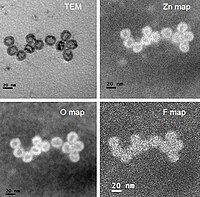
Photo from wikipedia
An aqueous-phase synthesis of 3-mercaptopropionic acid (3-MPA)-capped core/shell/shell ZnSeS/Cu:ZnS/ZnS QDs was developed. The influence of the Cu-dopant location on the photoluminescence (PL) emission intensity was investigated, and the results show… Click to show full abstract
An aqueous-phase synthesis of 3-mercaptopropionic acid (3-MPA)-capped core/shell/shell ZnSeS/Cu:ZnS/ZnS QDs was developed. The influence of the Cu-dopant location on the photoluminescence (PL) emission intensity was investigated, and the results show that the introduction of the Cu dopant in the first ZnS shell leads to QDs exhibiting the highest PL quantum yield (25%). The influence of the Cu-loading in the dots on the PL emission was also studied, and a shift from blue–green to green was observed with the increase of the Cu doping from 1.25 to 7.5%. ZnSeS/Cu:ZnS/ZnS QDs exhibit an average diameter of 2.1 ± 0.3 nm and are stable for weeks in aqueous solution. Moreover, the dots were found to be photostable under the continuous illumination of an Hg–Xe lamp and in the presence of oxygen, indicating their high potential for applications such as sensing or bio-imaging.
Journal Title: Nanomaterials
Year Published: 2022
Link to full text (if available)
Share on Social Media: Sign Up to like & get
recommendations!